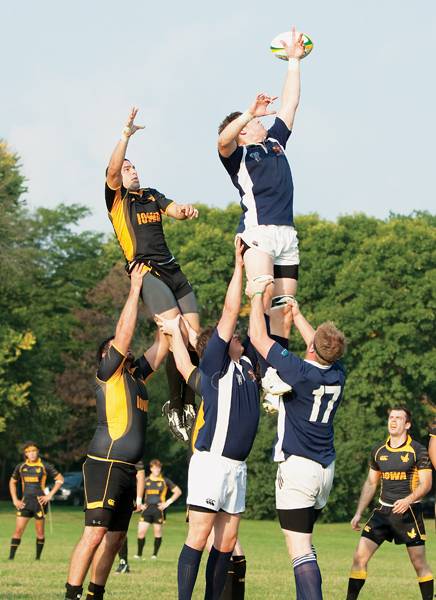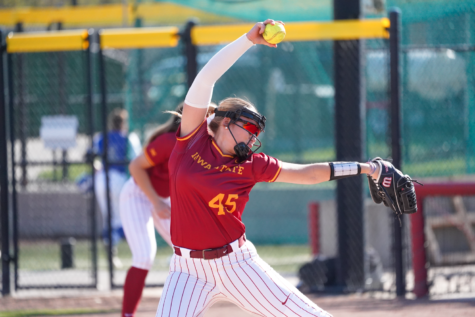RUGBY: Spread attack makes up for small size

The Iowa and ISU rugby teams fight for the ball during a lineout in the teams’ match on Friday at Towers Intramural Field. Photo: Steven Fisher/Iowa State Daily
September 16, 2009
A big change to the ISU football team this season was the implementation of the spread offense, run by new offensive coordinator Tom Herman. Another team on campus, the Iowa State men’s Rugby Club team, is taking a similar approach by spreading out its offensive attack.
In rugby, this means the team will try to play a quicker game, keeping the ball out of the scrum and in the back line so that players can swing the ball up the field and keep the ball in their opponent’s territory.
“We know that if we keep the ball in their half [of the pitch], we will score eventually,” said senior forward Curtis Schaefer.
In his fifth year with the team, head coach Malcolm Robertson has never played with a team smaller in size than this one. In collegiate rugby, players in the pack, or forwards, usually weigh more than 240 pounds, with some weighing as much as 300 pounds. The Cyclones’ biggest players in the pack weigh in at just around 230 pounds.
“In the past, we used more power because a lot of the teams in Iowa are big,” Robertson said. “Now we must focus on more continuous play and less breakdowns.”
The team was able to try out the spread attack in its season opener last Friday as the Cyclones took on the Iowa Hawkeyes in one of the many Iowa-Iowa State matchups last weekend. The Cyclones came out of the gates strong, with three tries in the first half, and tackled well all game to hold the Hawkeyes to only five points in their 26–5 victory. Robertson saw his team play with a lot of passion, but also saw that some of the bigger Iowa players were able to out-muscle some of the Cyclone forwards.
“I knew we would get pushed around a bit,” Robertson said.
One of the bigger players on the team, senior Marc Hempstead, knows his smaller pack will be at a size disadvantage, especially in the scrum, but is optimistic about Iowa State’s finesse approach.
“If we can run for 80 minutes, there’s no big guy that can keep up with us,” Hempstead said.
Season Preview — Because rugby is not an NCAA-sanctioned sport, Iowa State plays in a conference with the University ofNorthern Iowa, Minnesota, Illinois, Wisconsin-Madison and Wisconsin-Stout in the Midwest Conference.
According to players, their biggest rivalries are with Northern Iowa, Minnesota and Illinois. One reason for the rivalries, besides being in the same conference, is that Iowa State usually has fewer players on its team. Iowa State usually dresses 20 to 25 players, while schools like Minnesota and Illinois have been known to suit up 55 or 60 players.
“We like being the rag-tag group,” said senior forward Ben Roby.
Proximity is also another key to these rivalries.
“You always want to beat the states you’re touching,” Hempstead said.
Last year, the team was in Division I for the first time. The team went 2–3 last season in league play, nearly making the playoffs. A new rule this season will demote teams that finish in the bottom of the conference back down to Division II. After narrowly missing post-season play, it’s clear that the team would like to remain in Division I and make some noise in the post-season.
“To stay in D-1, it’s a big deal,” Hempstead said. “We owe it to the guys that got us into D-1 to play hard and stay here.”
















